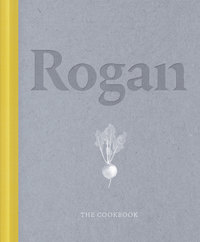
Полная версия
Rogan
To coat the dock pudding, blitz the breadcrumbs and dried leaves together in a blender to form a powder and put in a shallow dish. Put the beaten eggs in another shallow dish, and the flour in a third dish. Roll and coat the dock pudding balls first in the flour, then the egg and finally the breadcrumbs.
To make the ramson emulsion, blitz the parsley, ramsons and sunflower oil in a blender until smooth. Strain through a muslin-lined sieve and put straight into the fridge to chill. In a clean blender, blitz the soft-boiled eggs on medium speed. Add the green oil slowly until the emulsion has a mayonnaise consistency. Strain through a fine sieve to create a smoother texture and season with salt.
Deep-fry the dock pudding balls in batches in a pan of oil heated to 180°C until crisp and lightly golden, removing with a slotted spoon and leaving them to drain on kitchen paper. Serve with the ramson emulsion.
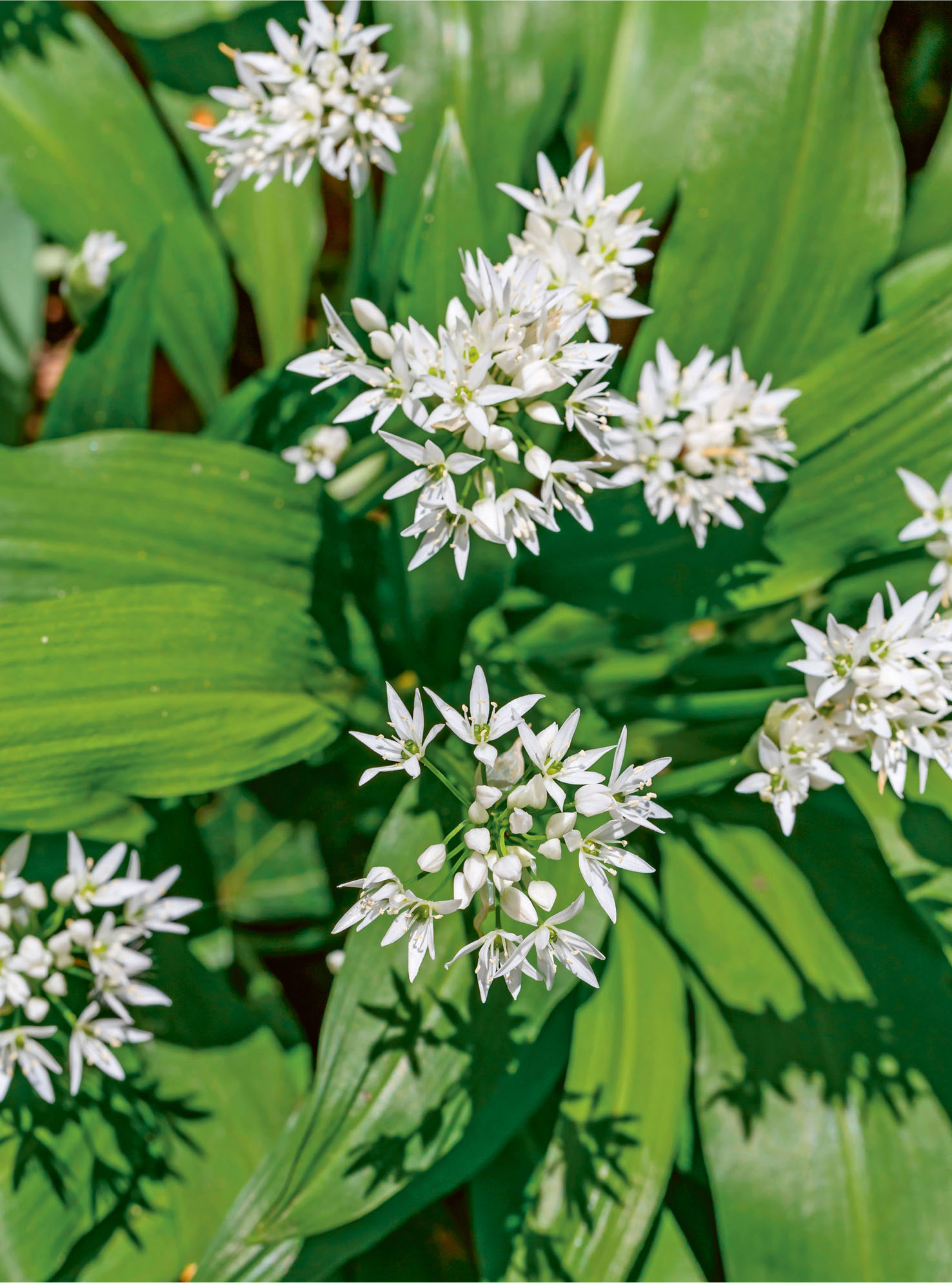
HALF-DRIED TOMATOES WITH ROSEHIP, MINT AND BONE MARROW CRUMB
Bone marrow is a much-neglected cut of beef shin, which is a shame because it gives a big protein hit and has an intense umami flavour. I’ve included rosehips here for their wonderfully fragrant aroma, and because I often forage for them near my home, so I’m always trying new ways to use them. For the best flavour, infuse the hips in the syrup for 24 hours. This recipe produces a lot of syrup, but it stores well and can be added to granola and yoghurt, drizzled over ice cream or tossed through summer berries.
SERVES 4, AS A STARTER
Rosehip syrup
500g rosehips
125g caster sugar
peel of 1 orange
juice of 1 lemon
Semi-dried tomatoes
500g mixed-colour cherry tomatoes (we use Sweet Olive, Golden Grape)
20ml rapeseed oil
a generous pinch of salt
Bone marrow crumb
200g bone marrow
50g panko breadcrumbs
1 tbsp finely chopped chives
Mint maltodextrin
75g mint leaves
100ml sunflower oil
30g maltodextrin
texsel greens and rapeseed oil, to serve
For the rosehip syrup, put all the ingredients in a large, heavy-based saucepan with 375ml water and bring to the boil over a medium heat, then reduce the heat and simmer for 15 minutes. Remove from the heat and leave to cool. Cover, transfer to the fridge and allow to infuse for 24 hours. Pass through a muslin-lined sieve, discard the pulp and leave to one side.
Preheat the oven to 80°C/60°C Fan (if you have a gas oven, set it to the lowest setting and leave the door slightly ajar). Bring a large pan of water to the boil and blanch the tomatoes for 30 seconds. Remove with a slotted spoon and plunge them into iced water to stop the cooking process. Once cool enough to handle, peel away the skin. Place the tomatoes as a single layer on a baking tray, dress with the oil and salt and dehydrate in the oven for 5 hours until jammy and slightly dry. Remove from the oven and leave to one side.
Cook the bone marrow in a small, heavy-based saucepan over a low heat to release the fat. Strain the fat and discard the solids. In a medium pan over a medium heat, toast the breadcrumbs in the bone marrow fat for a few minutes, stirring continuously until evenly brown. Drain on kitchen paper and leave to cool. When cool, fold in the chives.
While the marrow crumb is cooling, bring a large saucepan of water to the boil and blanch the mint for 1 minute. Remove the leaves with a slotted spoon and refresh in a bowl of iced water. Drain, squeeze out the excess water and blitz the mint with the oil in a blender. Strain the mint oil through a muslin-lined sieve into a bowl. Put the maltodextrin in a small bowl, then add the oil a teaspoon at a time to create a crumb.
Pour a small amount of syrup into each bowl (the leftover syrup will keep for 1 week) and put the semi-dried tomatoes on top. Add small piles of the mint maltodextrin and marrow breadcrumbs, sprinkle each serving with texsel greens and drizzle with rapeseed oil.
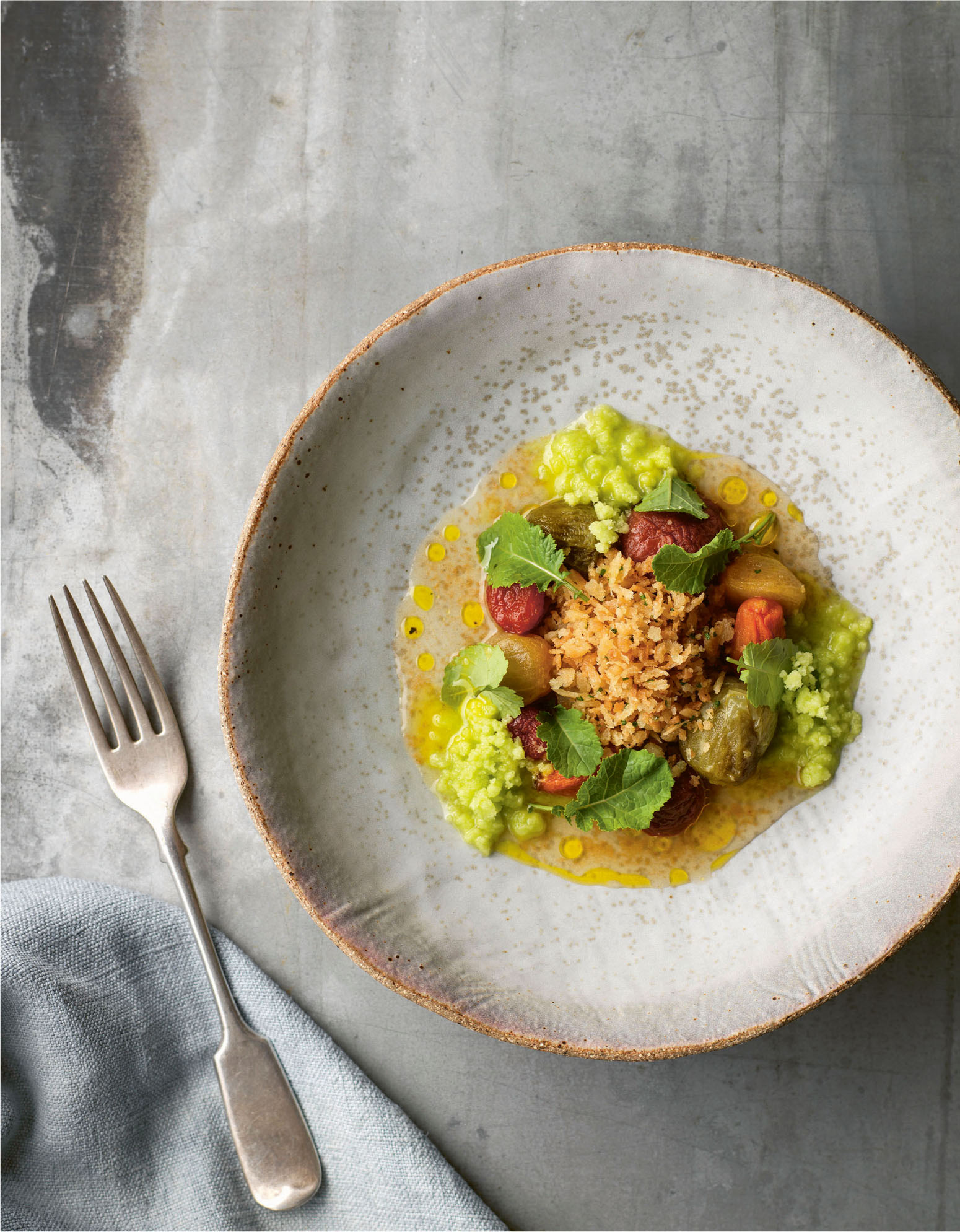
KALIBOS CABBAGE WITH MUSSELS AND PARSNIP SAUCE
At Our Farm we grow a wonderful variety of cabbage called Kalibos. It is red with a firm heart and has a high sugar content, which gives it a delicious sweetness. Seeds are widely available if you fancy growing these yourself (it’s well worth the effort), but if not, use any young red cabbage – you might need to cook the leaves a little longer, depending on how tender they are. Perilla is a sweet, yet strongly aromatic herb which adds notes of anise, basil, cumin and citrus to the wonderful early autumn ingredients on this plate.
SERVES 4, AS A STARTER
Parsnip sauce and diced parsnip
1.4kg parsnips
1 litre whole milk
50g unsalted butter
Red cabbage
1 red cabbage, such as Kalibos
1 litre fresh apple juice
250ml red wine vinegar
1 red cabbage, juiced in a juicer
handful of perilla sprigs
Mussels
3 tbsp sunflower oil
2 shallots, thinly sliced
2 garlic cloves, thinly sliced
24 live mussels, washed thoroughly under cold running water, beards and grit removed
200ml white wine
2 sprigs of perilla
salt, for seasoning
micro perilla shoots, to serve
Thinly slice 1kg of the parsnips. In a large, heavy-based saucepan over a low heat, warm the sliced parsnips and milk together, removing the pan from the heat before the milk boils. Leave to cool and infuse for 3 hours.
Strain the milk through a fine sieve and discard the parsnip. Thinly slice 200g of the remaining raw parsnip and cook in the butter in a medium, heavy-based saucepan over a medium heat for 15–20 minutes, or until soft. Add the parsnip-infused milk to the pan, bring to the boil and immediately remove from the heat. Blitz until smooth with a hand-held blender. Pass through a fine sieve and leave to one side.
Separate the cabbage into individual leaves, discarding the larger, coarse outer ones. Combine the apple juice, vinegar and cabbage juice in a large saucepan and bring to the boil. Blanch the cabbage leaves in the boiling liquid for 1–2 minutes until tender. Remove from the liquid with a slotted spoon and drain on kitchen paper. Pour off 100ml of the blanching liquid and leave to one side. Add the perilla to the rest of the blanching liquid and reduce to a syrup over a low heat for 8–10 minutes. Remove the perilla sprigs and discard.
Preheat the oven to 200°C/180°C Fan/Gas Mark 6.
While the liquid is reducing, dice the remaining 200g parsnips into pieces the same size as the mussels, scatter over a baking tray, drizzle with 1 tablespoon of the sunflower oil and bake in the oven for 10–12 minutes, or until tender.
For the mussels, warm the remaining 2 tablespoons of the oil in a medium heavy-based saucepan over a medium heat, add the shallots and garlic and sweat for 3–4 minutes until translucent. Turn up the heat and add the mussels, wine and perilla. Cover and cook for 3–4 minutes, or until the shells have opened. Remove the pan from the heat and remove the meat from the shells. Discard any shells that have not opened.
Wrap the mussels and diced parsnips in the blanched kalibos leaves to make eight parcels and warm them through in the reserved 100ml of blanching liquid. When warm, remove from the liquid and brush with the kalibos syrup.
Divide the cabbage parcels among plates and finish with the parsnip sauce and micro perilla shoots.
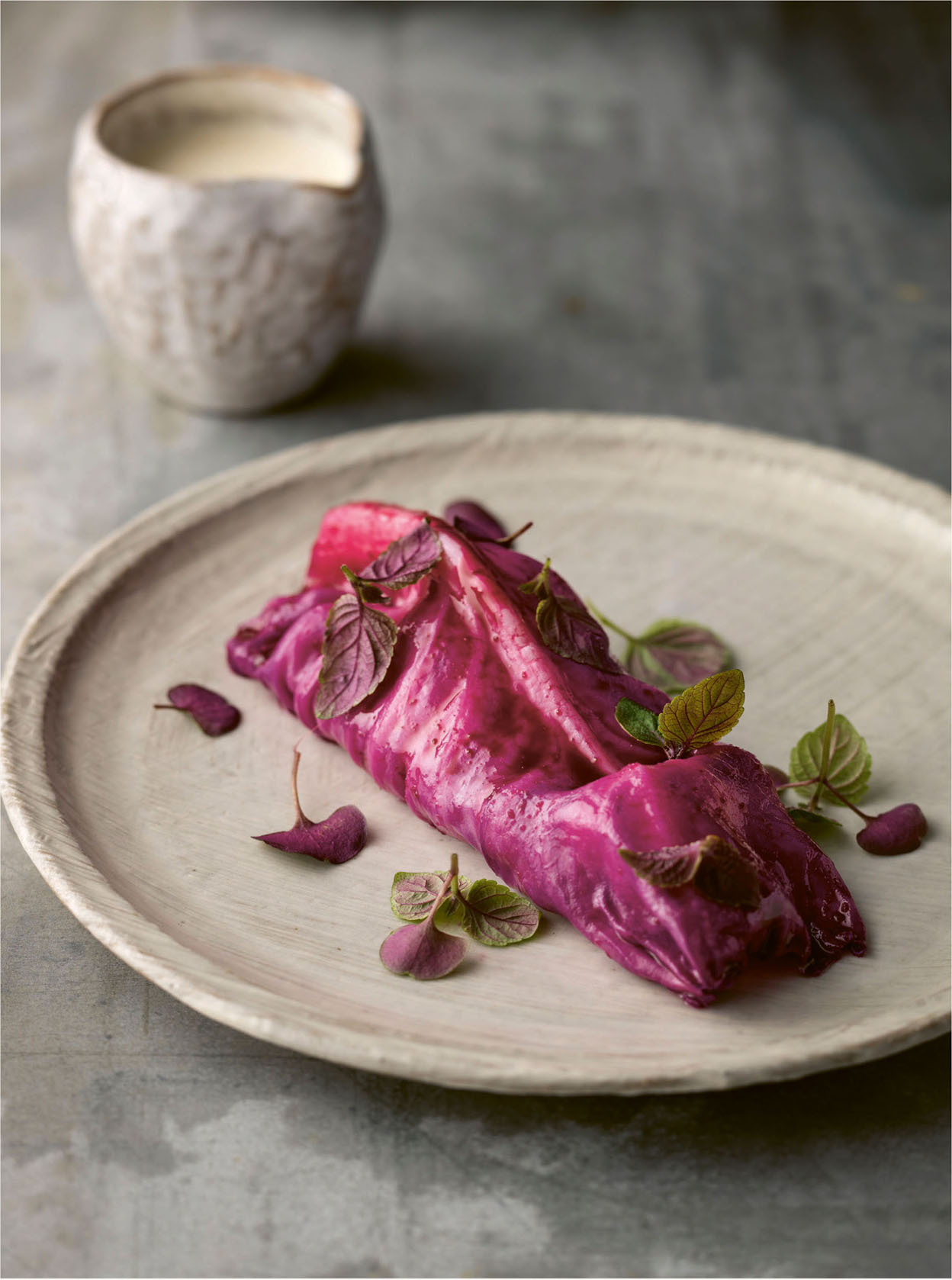
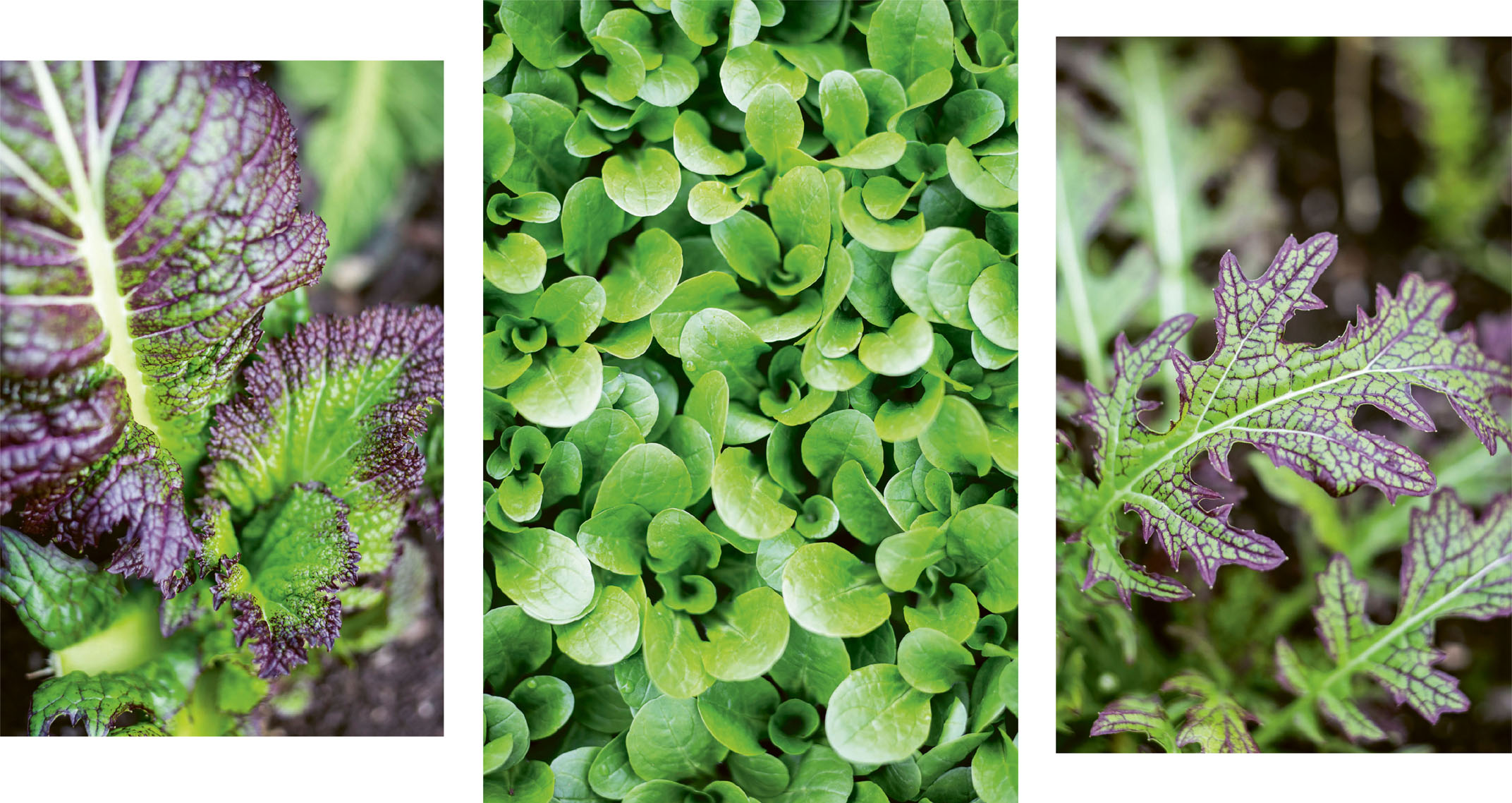
DUNCAN CABBAGE WITH OYSTERS, PUFFED PORK AND HYSSOP SAUCE
Make sure your oysters are really fresh – the oyster season begins in September and lasts for as long as there is an R in the month. They should smell of the sea, be firm in texture and surrounded by natural juice, and the heel of the oyster should be a creamy white colour. Hyssop is a strongly aromatic herb, similar to Mediterranean herbs such as lavender and rosemary, and its potent, hot and bitter flavours add a real kick to the salty, briney oysters. The pork adds a crunchy contrast to the chewy oysters, but it needs at least 12 hours in the oven to dry out properly. Put it in overnight and it will be ready by morning.
SERVES 4, AS A STARTER
1kg pork skin
1 tight-headed cabbage, such as Duncan
12 large fresh oysters
vegetable oil, for deep-frying
Hyssop sauce
4 tbsp sunflower oil
2 shallots, thinly sliced
½ fennel bulb, thinly sliced
15ml chardonnay vinegar
200ml white wine
150ml double cream
250g unsalted butter
20g anise hyssop
a pinch of salt
hyssop flowers, to serve
Put the pork skin in a large heavy-based saucepan and cover with water. Bring to the boil, then reduce the heat to a simmer. Simmer uncovered for 3 hours, or until soft and tender. Drain and remove any excess fat or meat from the skin. Cut the skin into 1cm squares, transfer to a baking tray and dry in the oven on its lowest temperature for at least 12 hours, or until completely dry.
To make the hyssop sauce, warm 2 tablespoons of the oil in a large, heavy-based saucepan over a medium heat and sweat the sliced shallots and fennel with the pinch of salt for 3–5 minutes, or until the shallots have become translucent. Deglaze the pan with the vinegar and white wine and reduce for about 3 minutes to a slightly thicker syrup consistency. Add the cream and 30ml water and bring to the boil, then reduce the heat and simmer for 5 minutes. Whisk in the butter gradually, a small piece at a time, to thicken the sauce. Remove from the heat and add the hyssop. Cover and leave to infuse for 30 minutes. Strain through a fine sieve and leave to one side.
Preheat the oven to 200°C/180°C Fan/Gas Mark 6. Remove any loose outer leaves from the cabbage to expose the heart, then cut the cabbage heart into quarters through the root. Warm the remaining 2 tablespoons of the oil in a large, ovenproof non-stick frying pan over a medium heat and colour both cut sides of the cabbage quarters until deeply golden, then finish the cooking in the oven for 10–12 minutes.
Shuck the oysters, keeping the juice and the meat separate. Pass the juice through a fine sieve into a small saucepan. Over a high heat, bring the oyster juice to the boil then immediately remove from the heat. Add the oysters and let them poach lightly for 30 seconds–1 minute in their own juices off the heat.
Deep-fry the pork skin in batches in a saucepan of oil heated to 180°C for about 1 minute until puffed and crisp like pork scratchings. Remove from the hot oil with a slotted spoon, leave to drain on kitchen paper and season them with salt.
Meanwhile, gently heat the hyssop sauce over a low heat to warm it through.
Fan the cabbage out on each plate, scatter the poached oysters and crispy pork on top, finish with the warm sauce and scatter over the hyssop flowers.
TORCHED MACKEREL WITH CHICORY MARMALADE AND TOASTED BARLEY SAUCE
Blowtorching is a simple but effective way of cooking fish; the flame comes into direct contact with the mackerel, giving it a smoky, charred flavour. Mackerel works really well with strong, slightly acidic flavours, so the bitter chicory and orange marmalade balanced with a touch of sugar is is the perfect partner. Barley is often limited to soups and risottos, but toasting the grains gives them a wonderful depth of flavour and nuttiness. In the past I have given rosemary a supporting role because I’ve felt there are other, more interesting herbs, but I’ve come to really appreciate its qualities and here its warm, peppery notes allow the flavours of the pine and nutmeg to develop.
SERVES 4, AS A STARTER
Toasted barley sauce
80g pearl barley, plus 25g cooked
375ml White Chicken Stock
4 sprigs of rosemary
125ml whole milk
1 soft-boiled egg (cooked for 4 minutes)
lemon juice, for seasoning
Torched mackerel
25g coriander seeds
25g fennel seeds
500g rock salt
250g caster sugar
zest of 1 lemon
4 fresh mackerel fillets, skin on
Chicory marmalade
1 tbsp sunflower oil
30g unsalted butter
600g chicory, thinly sliced
20g caster sugar
350ml orange juice
Maldon sea salt, for seasoning
land seaweed, to serve
Preheat the oven to 200°C/180°C Fan/Gas Mark 6.
For the sauce, toast the 80g pearl barley on a baking tray in the oven for 35–40 minutes until golden brown. Remove from the oven and leave to one side to cool. In a medium, heavy-based saucepan over a high heat, bring the chicken stock to the boil with the rosemary sprigs, then remove from the heat, add the toasted barley and allow to infuse for 1 hour.
Strain the barley from the stock and discard. Blitz the infused stock in a blender with the milk, egg and cooked barley until smooth, then pass through a fine sieve and season with lemon juice and salt.
For the mackerel, toast the coriander and fennel seeds in a dry non-stick frying pan over a medium heat for 4–5 minutes, then blitz them to a powder in a blender or grind them in a pestle and mortar. Combine the ground seeds in a bowl with the salt, sugar and lemon zest and mix well. Dust the mackerel fillets evenly on both sides with the salt mixture. Transfer to a plate and leave to cure in the fridge for 10 minutes. Rinse the fillets under cold running water and pat them dry with kitchen paper.
While the mackerel is curing, start the chicory marmalade. Preheat a medium heavy-based saucepan over a medium heat. Put the oil and butter in the saucepan with a pinch of salt, then add the chicory and sauté for 8–10 minutes until all the liquid has evaporated and the chicory is soft. Add the sugar and cook for a further 5 minutes to caramelise it, then add the orange juice, reduce the heat and reduce the liquid to a glaze.
Using a blowtorch, torch the skin side of the cured mackerel until lightly charred and smoky.
Spoon the warmed chicory marmalade on to the centre of each plate. Put the torched mackerel fillets on top and spoon the warmed sauce around. Finish with land seaweed and Maldon sea salt.
SALT COD MOUSSE, BLACK RADISH AND RAMSON SAUCE
In early spring, all around Cartmel ramsons fill the air with their distinctive garlicky aroma. The season is brief, so we like to make as much use of it as we can, such as in this vibrant and delicious green sauce. This recipe makes a good quantity of sauce, but any left over can be kept in the fridge, covered, for 3–5 days and used with any simple dishes, such as grilled lamb chops. You need to plan ahead with this dish – the fish needs curing for 1 hour and the mousse needs to set in the fridge for a minimum of 3 hours for perfect flavouring and consistency.
SERVES 6, AS A STARTER
Salt cod mousse
125g fresh cod fillet, skinned
15g fine salt
40g flat-leaf parsley leaves
50ml sunflower oil
2½ gelatine leaves
130g potatoes (preferably Maris Piper), peeled and cut into even-sized chunks
300g crème fraîche
Ramson sauce
250g ramson leaves
2 tbsp sunflower oil
2 medium shallots, thinly sliced
200ml whole milk
200ml double cream
Black radish
1 large black radish, or any other radish
4 tsp salmon roe
salt, for seasoning
tagetes leaves and flowers, to serve
Dust the cod fillets with the salt and place on a plate in the fridge to cure for 1 hour. Rinse off the salt under cold running water and pat the fillets dry with kitchen paper. Blitz the parsley and oil together in a blender until smooth, strain through muslin into a bowl and put to one side.
Preheat the oven to 170°C/150°C Fan/Gas Mark 3.
Soak the gelatine in cold water for a few minutes until softened. Drain, squeeze out the excess water and leave the gelatine to one side.
Cook the potatoes in a saucepan of water over a high heat until tender. Bake the cod fillets on a baking tray for 6–8 minutes until flaky.
Drain the potatoes and flake the cod, and blitz them together in a blender with the softened gelatine leaves until smooth. Press through a fine sieve and fold in the parsley oil and crème fraîche. Transfer to an airtight container and leave in the fridge for 3 hours to set.
To make the sauce, bring a large saucepan of water to the boil and blanch the ramsons for 2 minutes. Remove from the water with a slotted spoon and transfer to a bowl of iced water to stop it cooking. Drain and squeeze out the excess water. In a medium, heavy-based saucepan, heat the oil over a medium heat and sweat the sliced shallots for 3–5 minutes, or until translucent. Add the milk and cream and bring to the boil, reduce the heat and simmer until reduced by two-thirds. Pour into a blender, add the blanched ramson leaves and blitz until smooth, then strain through a fine sieve into a bowl, cover and chill.
Just before serving, peel and slice the radish lengthways on a mandoline to create thin rectangles and season with salt just before serving.
Spoon the mousse into the centre of each bowl, shape the radish slices into curls and place alongside. Spoon the salmon roe on top of the mousse and finish with the green sauce and tagetes leaves and flowers.
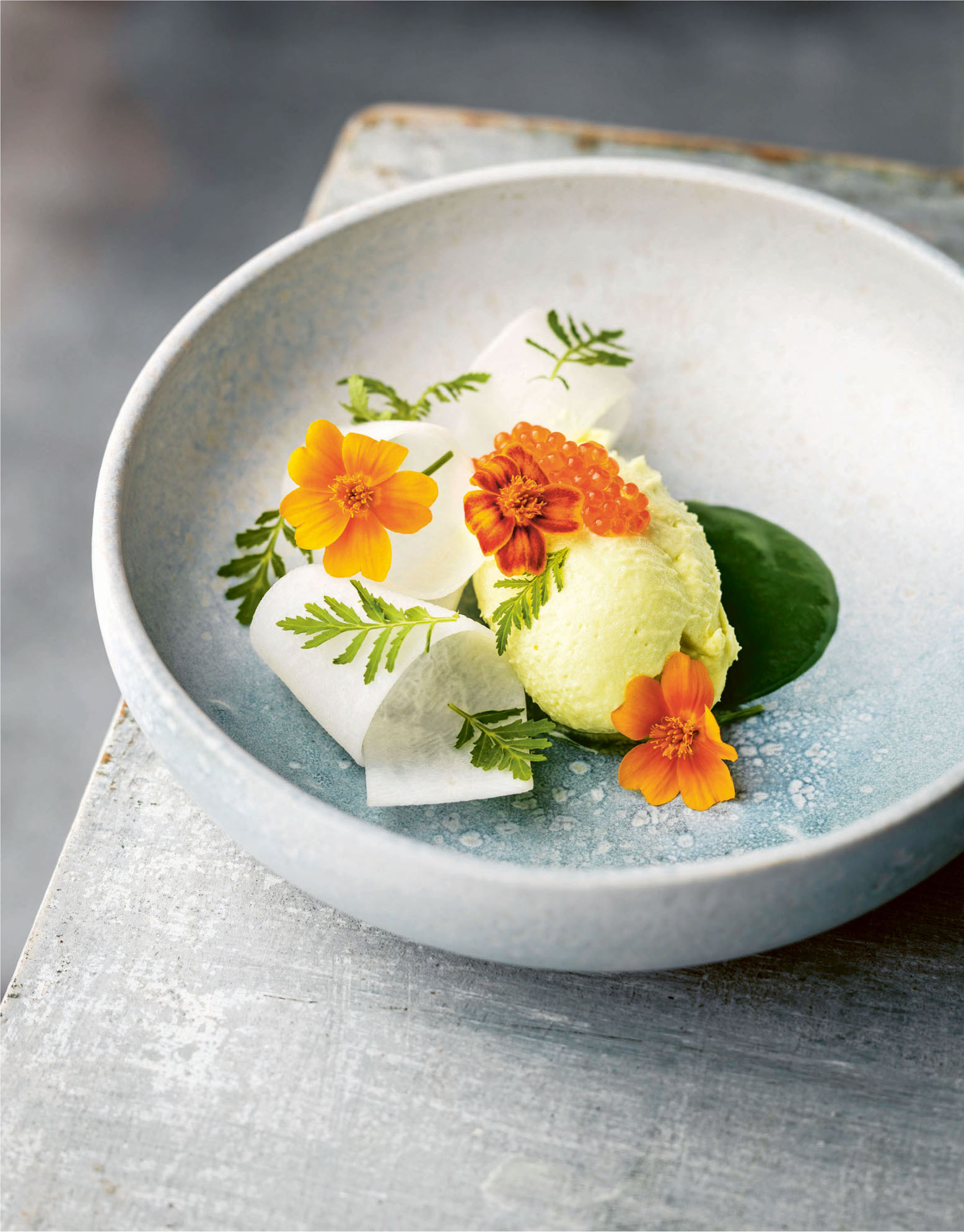
ACCORD RADISH, CURED ARCTIC CHAR AND LEMON THYME
This is a real showstopper. The fish and prawn infusions need to be prepped two hours ahead, so you can prepare this in stages. This dish uses just the shells of the prawns, so either peel them off and freeze the prawns for another day, or use shells from another recipe. Arctic char is an underused fish similar in texture to salmon and trout but paler in colour; here it gets a lift from the lemon thyme gel, which adds spicy notes of clove, mint and camphor. We use pastry cutters to create a perfect flat mound of fish in the middle of the plate, but if you prefer a rougher look, pile it up and gently flatten it to support the radish discs.
SERVES 4, AS A STARTER
Arctic char
25g coriander seeds
25g fennel seeds
500g rock salt
250g caster sugar
zest of 1 lemon
250g fresh Arctic char fillets
Prawn oil
heads and shells from 250g fresh prawns (freeze the peeled prawns to use another day)
150ml sunflower oil
Lemon thyme gel
20g lemon thyme sprigs
1 level tsp agar agar
a pinch of salt
140g low-fat natural yoghurt
Radish
2 long radishes, such as Accord (about 250g)
salt, for seasoning
lemon thyme leaves and flowers, to serve
3.5cm and 6–7cm pastry cutters (optional)
In a dry, non-stick frying pan over a medium heat, toast the coriander and fennel seeds for 4–5 minutes. When toasted, grind to a powder in a blender or pestle and mortar. In a bowl combine the ground seeds with the salt, sugar and lemon zest and mix well. Dust the Arctic char fillets evenly on both sides with the salt mixture. Put on a large plate and leave to cure in the fridge for 1½ hours.
While the fish is curing, preheat the oven to 200°C/180°C Fan/Gas Mark 6 and roast the prawn shells for 12–15 minutes, or until they turn a deep red colour. Blitz the roasted shells with the oil in a blender. Add the oil to a medium, heavy-based saucepan and warm through over a very low heat. Be careful not to get the oil too hot. Remove from the heat and leave to infuse for 2 hours.
Meanwhile, make the lemon thyme gel. Pour 200ml water into a small saucepan and bring to the boil. Remove from the heat, add the lemon thyme, cover and leave to infuse for 30 minutes. Strain the infused water into a small, heavy-based saucepan and discard the lemon thyme. Add the agar agar and salt and cook for 1 minute. Take off the heat and strain through a fine sieve into a heatproof bowl, then put in the fridge to set until firm, about 5–10 minutes. Once set, blitz until smooth with the yoghurt in a blender.
When you are ready to assemble the dish, rinse the cured Arctic char fillets under cold running water and pat them dry with kitchen paper, then cut the Arctic char into 1cm dice. Strain the cooled infused oil through a fine sieve and season with a little salt. Slice the radish thinly on a mandoline – if you want a uniform finish, cut each slice into equal-sized rounds using a 3cm pastry cutter. Lightly season the slices with salt.
Divide the cured fish evenly among plates. For a smart look, press each portion of diced char into a 6–7cm pastry cutter to shape, or just mound the fish in the centre of the plate and gently flatten the top. Cover the fish with a circle of radish slices or discs. Drizzle the prawn oil and the gel around the plate and finish with a few lemon thyme leaves and flowers.
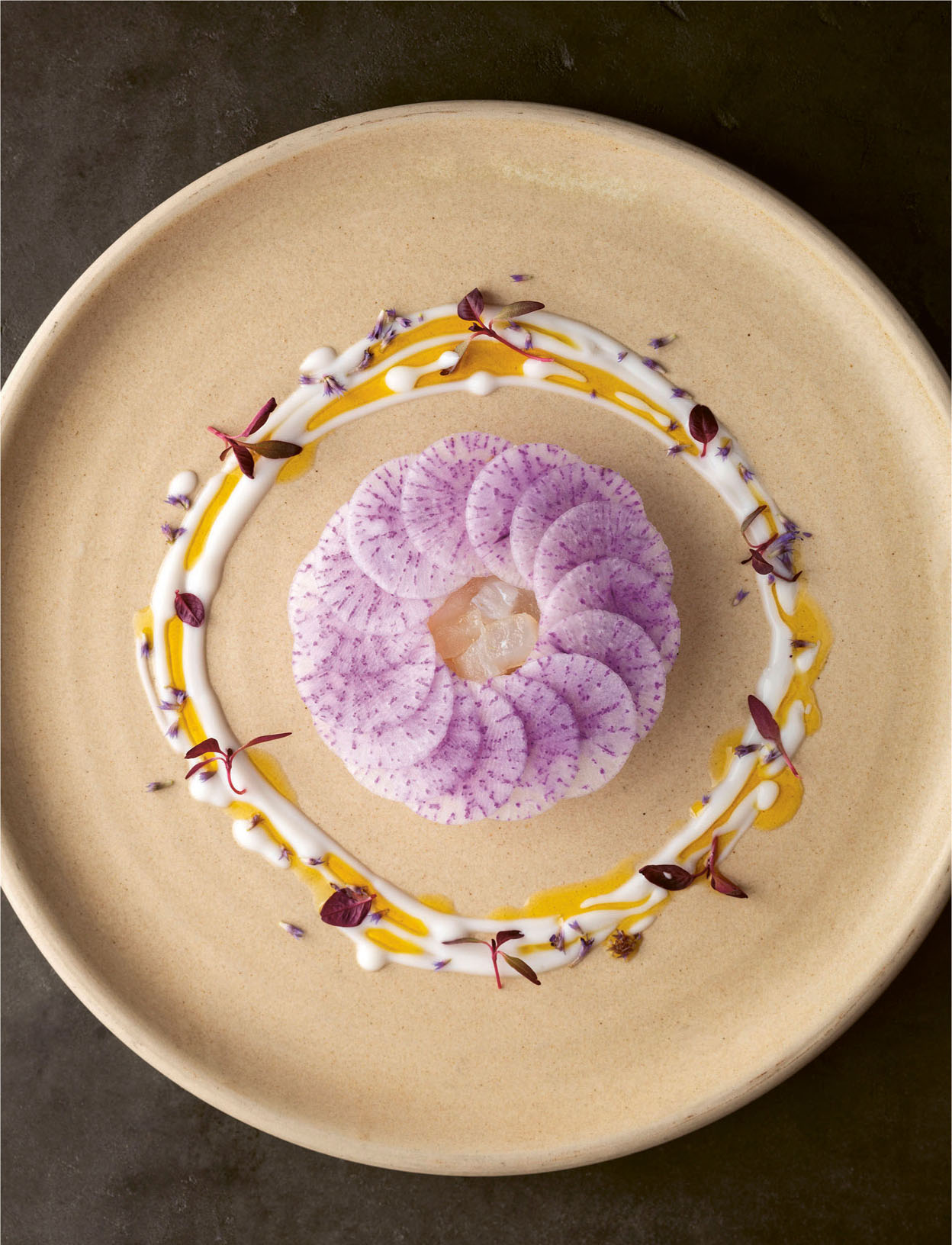
Sweet Cicely
(Myrrhis odorata)
From April right until October, the roadsides and fields around Cartmel are abundant with mounds of sweet cicely’s fern-like leaves and tiny white flowers (much beloved of bees, and so important, as they are the first nectar plants in spring), growing in any bare patch of soil they can find. It’s a prolific herb in Cumbria, where it is known as sweet brackens, which is how it appears on our menu. It has an incredibly long season, which is great for us as it has multiple uses in the kitchen, and this versatility is why this herb features so frequently in many of our dishes and why I also make sure that we preserve as much of it as we can for our larder. I’m a huge fan of the anise flavour, and this herb has it in spades – you can often smell a clump of sweet cicely before you see it.
Although sweet cicely grows on the roadside near the restaurant, I prefer to get a dawn start and forage for it on Bigland Hill, about 20 minutes away from Cartmel. I love going here before I start work; it is a high point in the landscape and on a clear summer morning the views are spectacular – and as an added bonus there’s no phone signal, so I can pick in peace!
We use every part of the plant: the light-green lacy leaves, the delicate white flowers, the long, pointed seeds, and even the roots ¬ which make a great wine. Every bit is infused with the aroma of sweet aniseed when crushed. The leaves have more flavour when young and before the plant puts its energies into its flowers, or you can wait for the seed pods in late summer, which have a sweet flavour and nutty texture. Once picked, the scent and flavours fade quickly, so they need to be used fresh, or if they are being preserved for another day, do it immediately. Be careful when picking this herb in the wild, though, as it looks similar to poison hemlock.
Sweet cicely complements a real array of ingredients. It is a natural sweetener, so the leaves and green seeds will reduce the tartness of rhubarb and gooseberries and add an anise note when used raw in fruit salads (it is especially good with peaches, apricots and strawberries), it also lends a spicy tang to cakes and makes beautiful ice cream. In savoury dishes it marries particularly well with fish and seafood, chicken and root vegetables, and it really lifts a green or cucumber salad. I like to use the fresh, barely opened flowers scattered over salads or as a garnish. Although sweet cicely already has a really long season, we like to extend it further by pickling the buds, using the leaves to make oils, salts and sugars, and dry the leaves for use over the winter. Its flavour does dissipate on cooking, though, so you need to add it to a hot dish at the end to get the best from it – it’s fantastic in soups, stews and sauces.




